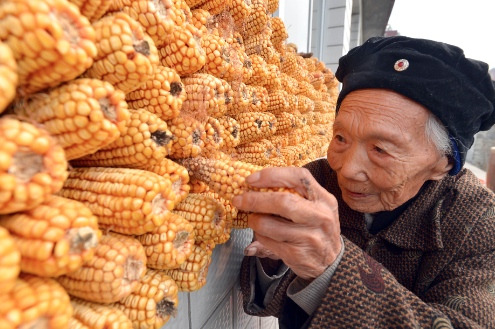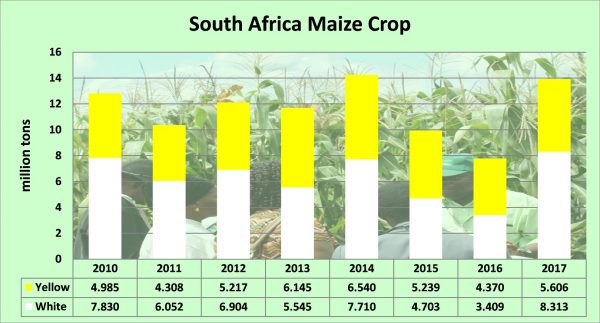

Follow us on:  
|


China is one of the biggest importers of South African maize [Xinhua]
“The positive value add effect up and down the respective value chains, including especially maize, will in our estimation contribute a full percentage point to total GDP, which is a very significant figure given our country’s low growth trajectory and looming downgrade threats by the rating agencies,” Purchase said.
The 2016 GDP growth data will be released on March 7. Growth slowed from 2.3 per cent in 2013 to 1.6 per cent in 2014 and 1.3 per cent. The Treasury estimated in the February 2017 Budget that growth in 2016 would only be 0.5 per cent before rising to 1.3 per cent in 2017.
The recovery in the maize harvest follows two years of sub-par harvests caused by the lack of sufficient rain. Maize needs 450 mm to 600 mm of water per season, which is mainly acquired from summer rains.
At maturity, each maize plant will have consumed 250 litres of water, which is why many South African maize farmers have moved from water-stressed South Africa to Zambia where there is more abundant rain.
No other crop utilises sunlight more effectively than maize, and its yield per hectare is the highest of all grain crops.
The products of maize not only feed humans and animals, but are also used in a variety of other downstream products, which is why Agbiz talks about the value chain.
By-products
The starch part of the kernel is used in foods and many other products such as adhesives, clothing, and pharmaceutical tablets and in paper production. The starch can be converted into sweeteners and used in products such as soft drinks, sweets, bakery products and jams. The oil from the embryo is used in cooking oils, margarine and salad dressings. The protein, hulls and soluble part of the maize kernel are used in animal and poultry feed.
The national annual rainfall in 2015 was the lowest since national record keeping started in 1904, but in 2017 there has been a recovery in rain as the el Nino effect has abated with many weather stations showing rain similar to that of 2014.

2014 was a record year in maize production, but as output fell so did GDP growth
Apart from the economic growth and farm income benefits, Agbiz further expects the rate of food inflation to decrease significantly, especially from the third quarter onward.
“We are confident that South Africa’s relatively high food inflation, due to the massive multi-year drought effect, has now peaked and the rate of increase is already starting to slow down. If we realize a crop of around 14 million tons of maize, we would have approximately 3 million tons surplus for export purposes, which again will assist our balance of payments considerably, and contribute to the strengthening of the rand. Economic growth and employment prospects in the whole agro-food value chain certainly are more positive now,” Purchase said.
The March white maize futures contract price has more than halved to R2 500 per ton in January 2017 from R5 296 per ton in January 2016.
The high maize price last year meant that the producer price inflation for farm products peaked at 24.9 per cent year on year (y/y) in February 2016, but has now plunged to a 2.9 per cent y/y decline in January 2017.
Farm prices at the producer level feed through to the retail level with a lag of four months, so food prices for the consumer should fall drastically from April onwards. Maize is harvested from May through to August depending on when the farmer planted his fields.
In addition to the impact on maize, many other summer crops are also expected to see large increases in harvests. Groundnut production is expected to increase by 399 per cent, sorghum by 100 per cent, dry beans by 82 per cent and soybeans by 44 per cent.
The rand has gained 20 per cent in January 2017 compared with January 2017 in part due to a 40 per cent rise in exports over the same period and the increased summer grain exports should support the rand going further.
A 3 million ton maize export total this year should add around $600 million to South Africa’s export total.
Francois Strydom, the Group Chief Executive of farmers’ cooperative Senwes told The BRICS Post that farm income should increase by some 20 per cent on average.
“The 20 per cent is an average as in specific cases such as those of irrigated farms there will be no change, while in others where there was no crop harvested last year due to the drought, there will now be an income. In terms of employment there should be no immediate reaction, rather it is a case of halting the losses as farmers continue to mechanise to improve productivity,” Strydom said.
Tractor sales in 2016 fell by 11.3 per cent to 5,855 units, according to the South African Agricultural Machinery Association and the industry body expects no further declines this year.
According to the Quarterly Labour Force Survey by Statistics South Africa, farm employment increased by 6.9 per cent or 59,000 to 919,000 between the fourth quarter 2015 and the fourth quarter 2016.
Helmo Preuss in Pretoria for The BRICS Post